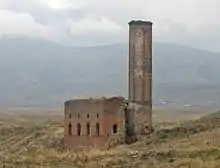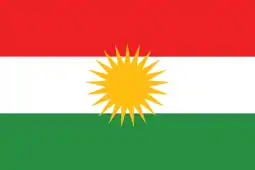Spread of Islam among Kurds
Spread of Islam among Kurds started in the 7th century with the Early Muslim conquests.[1] Before Islam, the majority of Kurds belonged to the Zoroastrianism religion. Kurds were a nation divided between the Byzantine and Persian Empires when Islam first appeared. Jaban al-Kurdi and his son Meymun al-Kurdi were the first Kurds who converted to Islam and Halîl al-Kurdi es-Semmâni was one of the first Kurdish tabi'uns.[2][3][4][5][6][7][8] However, mass conversion of Kurds to Islam didn't happen until the reign of Umar ibn Al-Khattab, second caliph of the Rashidun Caliphate between 634-644.[9][10] Today the majority of Kurds are Sunni Muslims, and there are Alevi and Shia minorities. Sunni Muslim Kurds are mostly Shafiʽis and Hanafis.[11]

Abu Hanifa Dinawari was one of the first Muslim scholars that studied Kurdish history and anthropology, and is said to have been a Kurd.[12] Bassami Kurdi (9th century), Abdussamed Babek (972-1019), and Ali Hariri (1009-1079) were the first Kurdish Islamic poets and authors.[13] Fakhr-un-Nisa (1091-1179) was the first female Kurdish Islamic scholar, muhaddith and calligrapher.[14] The Abulfeda crater in the Moon was named after Kurdish Islamic geographer and historian Abulfeda (1273-1331).[15]
Menüçehr Mosque, the first mosque in the current borders of Turkey, was built in 1072 by the Kurdish Sunni Muslim dynasty Shaddadids.[16]
Kurdish madrasas

With the spread of Islam in Kurdistan, a new style of civilization was formed in the region. One of the grounds of this new civilization was madrasas. The first Kurdish madrasa was formed around 950s in Hamadan, Iranian Kurdistan. However, Saladin changed the educational status of madrasas where only Islamic sciences were taught, and started to teach many branches of science there, giving more importance to Kurdish lessons.[3][17]
Lessons taught in the Kurdish madrasas included Tafsir of Quran, Hadith, Fiqh, Logic, Statute, Mathematics, Astronomy, Medicine and Philosophy. Most of the books that were used as textbooks in Kurdish madrasas were in Arabic, and they were translated to Kurdish by educationalists. There was an obligation of at least one child in each household having the necessity of being educated in a madrasa among the Kurds. Around 80% of students in Kurdish madrasas were male.[18][19]
References
- Kennedy, Hugh (Hugh N.) (2004). The Prophet and the age of the Caliphates : the Islamic Near East from the sixth to the eleventh century (2nd ed.). Harlow, England: Pearson/Longman. ISBN 0-582-40525-4. OCLC 55792252.
- Ibn Hajar al-Asqalani, El İsabe fi Temyizi's Sahabe
- Adnan, Demircan. Kurds. p. 63.
- Izady, Mehrdad R. (1992). The Kurds : a concise handbook. Washington: Crane Russak. ISBN 0-8448-1729-5. OCLC 25409394.
- "Kürt sahabeler". Archived from the original on 8 December 2015.
- Mahmud al-Alusi, Ruhu'l Meani
- HAZAL, Kadri (2014-01-27). "Kürtler ve İslamiyet (1) - Kadri HAZAL". Risale Haber (in Turkish). Retrieved 2020-12-13.
- Şafak, Yeni (2012-07-25). "Araplar ve Kürtler-1". Yeni Şafak (in Turkish). Retrieved 2020-12-13.
- Biçer, Bekir (2014). İslam Coğrafyacılarının Eserinde Kürtler Hakkındaki Rivayetler. Tarih Okulu Dergisi.
- Tan, Altan. Kürt Sorunu. Timaş Yayınları. p. 67.
- Bois, Thomas. Kurds and Kurdistan. p. 148.
- W. Adamec, Ludwig (2009). Historical Dictionary of Islam. Scarecrow Press. p. 84. ISBN 978-0-8108-6161-9.
- Kurdo, Qanate. Tarixa Edebiyata Kurdî.
- Nadwi, Mohammad Akram (2007). Al Muhaddithat: the women scholars in Islam. London: Interface Publishers. p. 55.
- Encyclopedia of the History of Science, Technology and Medicine in Non-Western Cultures, (edited by) Helaine Selin, pp. 7–8, Kluwer Academic Publishers, Netherlands, 1997 Identifiants et Référentiels Sudoc Pour L'Enseignement Supérieur et la Recherche – Abū al-Fidā (1273–1331) (in French)
- "SHADDADIDS – Encyclopaedia Iranica". iranicaonline.org. Retrieved 2020-12-13.
- Zeki, Mehmed Emin. Kürtler ve Kürdistan Tarihi.
- قصاص, مروة أسماء; حبار, عبدالرزاق; شعبان, فرج (2018). "دور نظام المعلومات الإلكتروني في فعالية النظام الرقابي في شركات التأمين الجزائرية". مجلة الباحث: 31. doi:10.35156/0505-000-018-003.
- Editor, Rojevakurd (2016-05-29). "Medreseya Kurdî". Rojevakurd. Retrieved 2020-12-16.CS1 maint: extra text: authors list (link)
